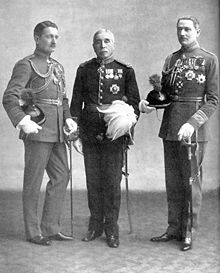Geoffrey Salmond

Sir William Geoffrey Hanson Salmond KCB , KCMG , DSO (* 19th August 1878 in Hougham , Kent ; † 27. April 1933 in London ) was a British officer in the Royal Air Force to the rank of Air Chief Marshal and the post of Chief of the Air Staff reached.
Life
Salmond was born the son of the officer and later Major-General William Salmond, his siblings included John Salmond , who served before him and shortly after his death as Chief of the Air Staff and rose to Marshal of the Royal Air Force . Geoffrey served after attending the Royal Military Academy Woolwich from 1899 to 1900 in the Royal Artillery in the Second Boer War in South Africa and was posted in November 1900 for use in the suppression of the Chinese Boxer Rebellion . From 1905 he served as a language officer in Japan, where he learned the Japanese language.
From 1908 he was adjutant of the Royal Artillery and from 1911 attended the two-year course at Staff College Camberley . After graduating, he immediately obtained, like his younger brother before him, a pilot's license ( Royal Aero Club Certificate No. 421) and was assigned to the reserve of the Royal Flying Corps , where he worked as a general staff officer in the Directorate of Military Aeronautics . When Great Britain entered the First World War , he was a captain and general staff officer 2nd degree on the staff of the RFC in the field. In January 1915 he became commander of No. 1 Squadron , which was used in the Battle of Neuve-Chapelle , in the Battle of Height 60 and at Aubers Ridge. In August 1915 he returned temporarily to England, where he was on his next assignment as commander of the No. 5 Wing was prepared in Egypt . In November 1915 his wing was first relocated to Heliopolis , in February 1916 to Ismailia , from where it intervened in the fighting on the Suez Canal and on the Sinai . On July 1, 1916, Salmond was promoted to temporary brigadier general when, with the assistance of another, No. 20th (Reserve) Wing RFC , the Middle East Brigade was formed under his command. From then on Salmond was responsible for a wide geographical area, which in addition to Egypt also included Mesopotamia and East Africa as well as the front in Macedonia and which Salmond himself traveled several times.
On January 3, 1918, after a stay in England, he took over as temporary Major-General the meantime formed HQ RAF Middle East . After the end of the war, when the new rank system was introduced in the RAF in August 1919, he was awarded the rank of Air Vice-Marshal . He remained in command of the RAF in the Middle East until February 1922. Back in England, he became an Air Member for Supply and Research in 1923 , before being transferred to British India in 1926 as Air Officer Commanding . Here he was promoted to Air Marshal on July 1, 1929 . In 1931 he returned to England to take over the post of Commander in Chief of the Air Defense of Great Britain . After his promotion to Air Chief Marshal on January 1, 1933, he succeeded his brother John on April 1 of the same year as Chief of the Air Staff (CAS). At this point he was terminally ill and died within a month. His brother held the office of CAS on a provisional basis until Edward Ellington was appointed .
Private
Salmond had married the daughter of William Carr in 1910, with whom he had three daughters and a son. In 2003 the biography From Biplane to Spitfire , written by one of his daughters, appeared about him.
literature
- Anne Baker: From Biplane to Spitfire: The life of Air Chief Marshal Sir Geoffrey Salmond KCB KCMG DSO. Pen & Sword, 2003, ISBN 0-85052-980-8 .
- Henry Probert: High Commanders of the Royal Air Force. HMSO, 1991, ISBN 0-11-772635-4 .
Web links
- Geoffrey Salmond on rafweb.org
| predecessor | Office | successor |
|---|---|---|
| Sir John Salmond |
Chief of the Air Staff 1933 |
Sir John Salmond (acting) |
| personal data | |
|---|---|
| SURNAME | Salmond, Geoffrey |
| ALTERNATIVE NAMES | Salmond, William Geoffrey Hanson (full name) |
| BRIEF DESCRIPTION | British Air Force Commander |
| DATE OF BIRTH | August 19, 1878 |
| PLACE OF BIRTH | Hougham , Kent |
| DATE OF DEATH | April 27, 1933 |
| Place of death | London |
